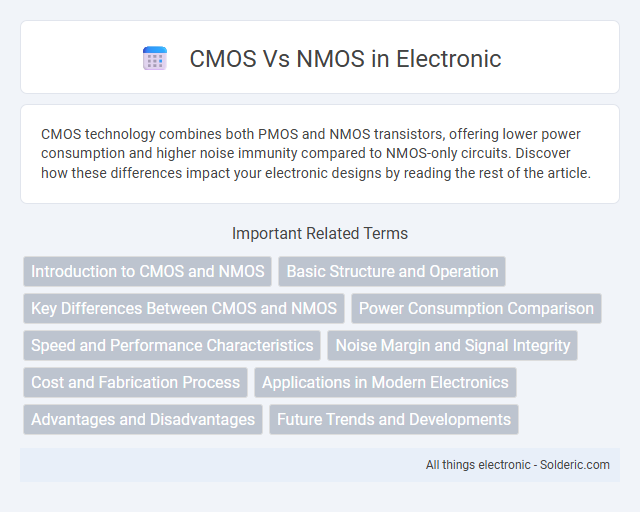CMOS technology combines both PMOS and NMOS transistors, offering lower power consumption and higher noise immunity compared to NMOS-only circuits. Discover how these differences impact your electronic designs by reading the rest of the article.
Comparison Table
| Feature | CMOS (Complementary MOS) | NMOS (N-Channel MOS) |
|---|---|---|
| Transistor Type | Combination of NMOS and PMOS | Only NMOS transistors |
| Power Consumption | Low static power, efficient | Higher static power, less efficient |
| Switching Speed | Moderate speed, balanced | Faster switching than CMOS |
| Noise Immunity | High noise margin | Lower noise margin |
| Complexity | More complex due to dual transistor types | Simple design |
| Area | Larger chip area | Smaller chip area |
| Use Cases | Widely used in digital ICs, microprocessors | Used in specific analog circuits, simpler logic |
Introduction to CMOS and NMOS
CMOS (Complementary Metal-Oxide-Semiconductor) and NMOS (N-type Metal-Oxide-Semiconductor) are fundamental technologies in semiconductor device fabrication, with CMOS utilizing both NMOS and PMOS transistors to achieve low power consumption and high noise immunity. NMOS transistors conduct when a positive voltage is applied to the gate, making them faster but often more power-hungry compared to CMOS circuits. Understanding the differences between CMOS and NMOS can help you optimize digital circuit design for efficiency and performance.
Basic Structure and Operation
CMOS technology combines both NMOS and PMOS transistors, where NMOS transistors conduct when the input is high, pulling the output to ground, while PMOS transistors conduct when the input is low, pulling the output to the power supply. NMOS transistors consist of an n-type channel between two n+ regions in a p-type substrate, and they operate by creating a conductive channel when a positive gate voltage exceeds the threshold voltage. Your circuits benefit from CMOS's low static power consumption and high noise immunity due to complementary action, whereas NMOS devices offer simpler structure with faster switching speeds but higher static power use.
Key Differences Between CMOS and NMOS
CMOS technology uses both p-type and n-type MOSFETs to achieve low power consumption and high noise immunity, whereas NMOS circuits rely solely on n-type MOSFETs, leading to faster switching speeds but higher power dissipation. CMOS devices exhibit complementary operation, enabling reduced static power consumption during idle states, while NMOS transistors consume more power due to continuous current flow in pull-up networks. The fabrication complexity and cost of CMOS are higher than NMOS, but CMOS integration supports higher density and more complex digital circuits in modern VLSI designs.
Power Consumption Comparison
CMOS technology significantly reduces power consumption compared to NMOS due to its complementary transistor arrangement, which minimizes static power dissipation by enabling current flow primarily during switching events. NMOS circuits consume continuous static power because they rely on a resistor pull-up network that creates a direct path from the power supply to ground when the transistor is on. This intrinsic power efficiency makes CMOS the preferred choice for battery-powered and low-power applications.
Speed and Performance Characteristics
CMOS technology offers superior speed performance compared to NMOS due to its lower power consumption and reduced heat generation, enabling higher switching speeds. NMOS transistors typically provide faster electron mobility, resulting in quicker switching times but suffer from higher static power dissipation. CMOS circuits achieve optimal speed and efficiency by combining both NMOS and PMOS transistors, minimizing delay and enhancing overall performance in digital applications.
Noise Margin and Signal Integrity
CMOS technology offers superior noise margin compared to NMOS due to its complementary transistor pairs, which provide better voltage swing and reduce static power dissipation. NMOS circuits tend to have lower noise margins, making them more susceptible to signal degradation and crosstalk in noisy environments. Your choice between CMOS and NMOS significantly impacts signal integrity, with CMOS ensuring more reliable digital switching and robust performance under varying electrical conditions.
Cost and Fabrication Process
CMOS technology generally incurs higher fabrication costs than NMOS due to its more complex process, requiring both p-type and n-type transistors for complementary operation, which enhances power efficiency and noise immunity. NMOS fabrication is simpler and less expensive, involving only n-type transistors, but results in higher power consumption and heat generation. Despite the increased initial cost, CMOS fabrication benefits from scalability and lower power dissipation, making it more cost-effective for high-density, low-power integrated circuits.
Applications in Modern Electronics
CMOS technology dominates modern electronics due to its low power consumption and high noise immunity, making it ideal for microprocessors, memory chips, and digital logic circuits. NMOS transistors, with faster electron mobility, are still preferred in high-speed switching applications and analog circuits, but CMOS's complementary design offers greater efficiency for your portable and battery-powered devices. Advances in CMOS fabrication enable continued scaling and integration, supporting the development of complex systems-on-chip (SoCs) found in smartphones, computers, and IoT devices.
Advantages and Disadvantages
CMOS technology offers low static power consumption and high noise immunity, making it ideal for battery-powered devices, but it has a more complex manufacturing process compared to NMOS. NMOS transistors provide faster switching speeds and simpler fabrication, which benefits high-speed digital circuits, yet they suffer from higher static power dissipation and poorer noise margins. Both technologies play crucial roles in integrated circuit design, with CMOS dominating modern electronics due to its energy efficiency, while NMOS remains useful in specific high-performance applications.
Future Trends and Developments
Future trends in CMOS and NMOS technology emphasize scaling down transistor sizes to enhance performance and energy efficiency in integrated circuits. Advances in materials such as high-k dielectrics and strained silicon aim to overcome short-channel effects and leakage currents in nanoscale devices. Emerging developments include the integration of FinFET and Gate-All-Around (GAA) transistor architectures to significantly improve switching speed and reduce power consumption in next-generation semiconductor technology.
CMOS vs NMOS Infographic

 solderic.com
solderic.com